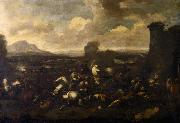China al por mayor de Marco de Oleo |
|||||||||||

|
|||||||||||
|
|
|
||||||||||||||
|
Jacques Courtois
(also called 'il Borgognone' or Giacomo Borgognone) (1621 - 20 May 1676?) was a French painter. He was born at Saint-Hippolyte, near Besançon. His father was a painter, and with him Jacques remained studying up to the age of fifteen. Towards 1637 he went to Italy, was received at Milan by a Burgundian gentleman, and entered, and for three years remained in the French military service. The sight of some battle-pictures revived his taste for fine art. He went to Bologna, and studied under the friendly tutelage of Guido Reni; thence he proceeded to Rome, where he painted, in the Cistercian monastery, the "Miracle of the Loaves." Here he took a house and after a while entered upon his own characteristic style of art, that of battle-painting, in which he has been accounted to excel all other old masters; his merits were cordially recognized by the celebrated Cerquozzi, named Michelangelo delle Battaglie. He soon rose from penury to ease, and married a painter's daughter, Maria Vagini; she died after seven years of wedded life. Prince Matthias of Tuscany employed Courtois on some striking works in his villa, Lappeggio, representing with much historical accuracy the princes military exploits. In Venice also the artist executed for the senator Sagredo some remarkable battle-pieces. In Florence he entered the Society of Jesus, taking the habit in Rome in 1655; it was calumniously rumoured that he adopted this course in order to escape punishment for having poisoned his wife. As a Jesuit Brother, Courtois painted many works in churches and monasteries of the society. He lived piously in Rome, and died there of apoplexy on 20 May 1676 (some accounts say 1670 or 1671). His battle-pieces have movement and fire, warm colouring (now too often blackened), and great command of the brush, those of moderate dimensions are the more esteemed. They are slight in execution, and tell out best from a distance. Courtois etched, with skill twelve battle-subjects of his own composition. The Danzig painter called Pandolfo Reschi in Italy was his pupil. His brother Guillaume was also a painter in Italy. |
||||||||||||||
|
|
||||||||||||||
|
||||||||||||||
|
|
||||||||||||||
| Jacques Courtois
(also called 'il Borgognone' or Giacomo Borgognone) (1621 - 20 May 1676?) was a French painter. He was born at Saint-Hippolyte, near Besançon. His father was a painter, and with him Jacques remained studying up to the age of fifteen. Towards 1637 he went to Italy, was received at Milan by a Burgundian gentleman, and entered, and for three years remained in the French military service. The sight of some battle-pictures revived his taste for fine art. He went to Bologna, and studied under the friendly tutelage of Guido Reni; thence he proceeded to Rome, where he painted, in the Cistercian monastery, the "Miracle of the Loaves." Here he took a house and after a while entered upon his own characteristic style of art, that of battle-painting, in which he has been accounted to excel all other old masters; his merits were cordially recognized by the celebrated Cerquozzi, named Michelangelo delle Battaglie. He soon rose from penury to ease, and married a painter's daughter, Maria Vagini; she died after seven years of wedded life. Prince Matthias of Tuscany employed Courtois on some striking works in his villa, Lappeggio, representing with much historical accuracy the princes military exploits. In Venice also the artist executed for the senator Sagredo some remarkable battle-pieces. In Florence he entered the Society of Jesus, taking the habit in Rome in 1655; it was calumniously rumoured that he adopted this course in order to escape punishment for having poisoned his wife. As a Jesuit Brother, Courtois painted many works in churches and monasteries of the society. He lived piously in Rome, and died there of apoplexy on 20 May 1676 (some accounts say 1670 or 1671). His battle-pieces have movement and fire, warm colouring (now too often blackened), and great command of the brush, those of moderate dimensions are the more esteemed. They are slight in execution, and tell out best from a distance. Courtois etched, with skill twelve battle-subjects of his own composition. The Danzig painter called Pandolfo Reschi in Italy was his pupil. His brother Guillaume was also a painter in Italy. between 1650(1650) and 1660(1660) Medium oil on canvas Dimensions Height: 114 cm (44.9 in). Width: 170 cm (66.9 in). cjr |
||||||||||||||
|
Related Paintings to Jacques Courtois :. |
||||||||||||||
|
|
||||||||||||||
|
|
||||||||||||||
|
CONTACTE EEUU |







